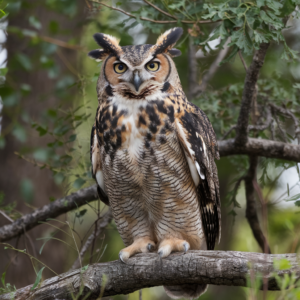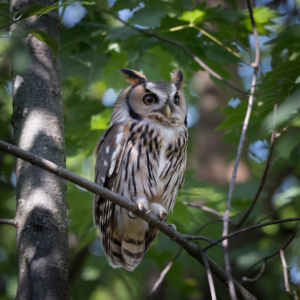Owls have long fascinated bird enthusiasts and nature lovers alike. Their mysterious nocturnal behavior, haunting calls, and silent flight make them some of the most intriguing birds in the wild. In Arkansas, owls are a common sight for those who know where and when to look. This guide will delve into the world of Owls in Arkansas, exploring their habitats, behavior, and conservation status, as well as offering practical tips on how to spot them.
Habitat and Range of Owls in Arkansas
Owls can be found across Arkansas, thriving in a variety of habitats. From the dense forests of the Ozark Mountains to the expansive wetlands of the Arkansas River Valley, owls have adapted to the state’s diverse ecosystems.
Regions and Habitats
- Forests: Many owl species in Arkansas, such as the Great Horned Owl, prefer thick forests, where they can easily find cover and hunt. The Ozark National Forest is a hotspot for such species.
- Wetlands and River Valleys: Wetland areas, such as those near the White River, are home to species like the Barn Owl, which prefers open habitats for hunting.
- Urban Areas: Owls like the Eastern Screech-Owl have adapted well to human environments, often nesting in parks, gardens, and backyards.
Food availability, nesting sites, and climate conditions influence owls’ habitat preferences. Seasonal migrations also affect where they are found, with some species, like the Northern Saw-whet Owl, appearing in Arkansas only during certain times of the year.
Common Owls Found in Arkansas
Great Horned Owl (Bubo virginianus)
The Great Horned Owl is one of North America’s largest and most powerful owls. It can be identified by its large size, “horned” ear tufts, and deep, booming hoot.
- Size and Wingspan: Typically 18-25 inches in height with a wingspan of up to 5 feet.
- Habitat: Prefers wooded areas but can also be found in deserts and urban areas.
- Diet: Hunts a variety of prey, including mammals like rabbits, skunks, and even other birds of prey.
The Great Horned Owl is known for its adaptability, making it one of the most widespread owl species in Arkansas. Due to its ferocious hunting habits, it is often called the “tiger of the sky.”

Eastern Screech-Owl (Megascops asio)
Smaller than the Great Horned Owl, the Eastern screech owl is a common sight in both rural and urban settings across Arkansas.
- Size: Around 8-10 inches tall, making it one of the smallest owls in the region.
- Habitat: Found in woodlands, parks, and even suburban gardens.
- Diet: Feeds on insects, small rodents, and occasionally birds.
Eastern screech owls are known for their distinctive trilling call, often mistaken for other nocturnal sounds.

Barn Owl (Tyto alba)
Recognized for its heart-shaped face and ghostly appearance, the Barn Owl is another frequent resident of Arkansas.
- Size: 12-15 inches tall, with a wingspan of about 3.5 feet.
- Habitat: Often seen in open fields, grasslands, and near farmlands.
- Diet: Specializes in hunting small mammals like voles and mice, thanks to its excellent low-light vision.
Barn owls are precious in agricultural regions for controlling rodent populations. In Arkansas, they are often spotted nesting in barns, abandoned buildings, or natural cavities.

Barred Owl (Strix varia)
The Barred Owl is one of Arkansas’s most vocal owls, known for its classic “Who cooks for you?” call.
- Size: 16-24 inches tall with a wingspan reaching 4 feet.
- Habitat: Prefers dense forests near water sources.
- Diet: Hunts small mammals, amphibians, and reptiles.
In Arkansas, the Barred Owl lives in forested areas, especially near the state’s many rivers and lakes.

Northern Saw-whet Owl (Aegolius acadicus)
The elusive Northern Saw-whet Owl is less commonly seen in Arkansas but does appear, especially during migration.
- Size: Small, about 7-8 inches in height.
- Habitat: Prefers dense forests, particularly in mountainous regions.
- Diet: Primarily hunts small rodents and birds.
Spotting this tiny owl is a rare treat for birdwatchers in Arkansas.

Owl Behavior and Diet in Arkansas
Owls are primarily nocturnal, meaning they are most active at night. Their large eyes and exceptional hearing allow them to hunt in the darkness and locate prey accurately.
Diet
Owls in Arkansas have varied diets, depending on their species and habitat. The Great Horned Owl, for example, is an apex predator known to take down large prey such as skunks and even other raptors. In contrast, the Eastern Screech-Owl and Northern Saw-whet Owl primarily feed on small rodents, insects, and birds.
Thanks to the structure of their feathers, owls can fly silently, giving them a significant advantage when hunting. Their powerful talons and sharp beaks ensure they can swiftly capture and kill their prey.
Owl Conservation and Threats in Arkansas
Owls play a crucial role in maintaining the balance of Arkansas’s ecosystems. However, they face numerous threats:
- Habitat Loss: As forests are cleared for agriculture or development, owls lose critical nesting and hunting grounds.
- Pesticides and Rodenticides: These chemicals not only reduce the prey available to owls but can also poison the birds themselves.
- Climate Change: Shifts in weather patterns can affect owl species’ food supply and migration habits.

Conservation Efforts
Various conservation programs in Arkansas focus on protecting owls and their habitats. Organizations like Audubon Arkansas work on preserving vital habitats and raising public awareness about the importance of these magnificent birds. Birdwatchers and naturalists are encouraged to participate in owl monitoring and habitat restoration projects.
How to Spot Owls in Arkansas
Owls are elusive creatures, but with the proper knowledge and a bit of patience, you can increase your chances of seeing them in the wild.
Best Places to Spot Owls
- Ozark National Forest: Home to the Great Horned Owl and Barred Owl.
- Buffalo National River: A prime location for spotting Barn Owls.
- White River National Wildlife Refuge: Known for its rich birdlife, including various owl species.
Tips for Owl Spotting
- Best Time: Owls are most active at dusk and dawn, although some, like the Barred Owl, may also hunt during the day.
- Equipment: Bring a good pair of binoculars and a flashlight with a red filter to avoid startling the birds.
- Use Owl Calls: Learning to imitate owl calls can help attract curious owls, especially during mating season.
FAQs
What owls are native to Arkansas?
Arkansas has several native owl species, including the Great Horned Owl, Barred Owl, Eastern Screech-Owl, and Barn Owl.
Where is the best place to see owls in Arkansas?
Popular owl-watching locations include the Ozark National Forest and the White River National Wildlife Refuge.
Are owls in Arkansas endangered?
While most owls in Arkansas are not currently endangered, they face habitat loss and human activity threats.
What do owls in Arkansas eat?
Owls in Arkansas typically hunt small mammals, birds, and insects. Larger species, like the Great Horned Owl, can take down bigger prey like rabbits and skunks.
Conclusion
Owls are an integral part of Arkansas’s natural landscape. Each species plays a vital role in the ecosystem, from the imposing Great Horned Owl to the tiny, elusive Northern Saw-whet Owl. Birdwatchers and nature lovers alike can take joy in spotting these magnificent birds in the wild while supporting conservation efforts to ensure their survival for future generations.
By understanding their habitats, behaviors, and conservation needs, we can better appreciate the beauty and significance of owls in Arkansas. So next time you’re out exploring the Ozarks or wandering along the Buffalo River, keep an ear out for the hoot of an owl—it might just be closer than you think.
This concludes the blog post, offering depth and variety in content while covering all the critical elements outlined earlier.
Read also: are birds affected by deer out spray?

